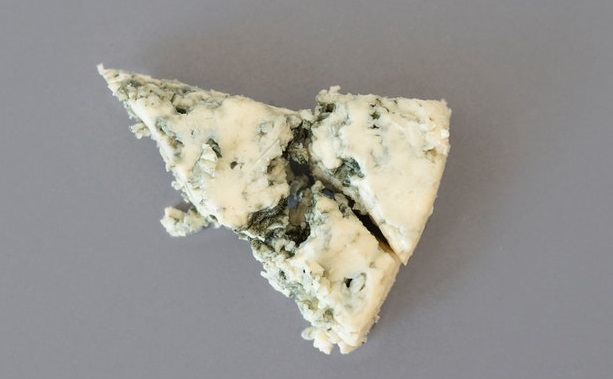
I learned this today. Blue cheeses (like stilton and gorgonzola) are blue because they have veins of penicillin running through them.
Legend says that blue cheese was discovered in the 7th century in a cave outside the village of Roquefort in France. The story is that a shepherd was eating a lunch of bread and cheese in a cave. He was distracted (the legend says by a girl) and didn’t return to the cave for several months. When he came back, his cheese had become streaked with mold. Luckily for us, instead of throwing it away, he ate it, liked the taste, and history was made. This is a nice story, but blue cheese was probably discovered when cheese was left in temperature and moisture controlled caves in the Middle Ages.
Gorgonzola is supposed to be the oldest blue cheese. It was created in 879 AD, but it didn’t have veins of mold until the 11th century. Stilton was created in the 1700s.
The mold that is in blue cheese is called penicillium roqueforti, in honor of the shepherd who is said to have discovered it. Penicillium roqueforti is a type of fungus.
To make blue cheese, you first have to make regular cheese. Cheese is made in a similar way to yogurt, in that they both use bacteria, but yogurt is made by fermentation, and cheese is made by acidification.
Milk is poured into a large vat and a culture of lactic acid bacteria is added. These bacteria eat the lactose in the milk to make energy. When they do that, they release lactic acid, hence their name. While the bacteria are doing their work, they lower the pH of the milk, making it more acidic. At this point, rennet is added.
Rennet is a group of enzymes that are produced in the stomach of a herbivore like a cow or a sheep. They are enzymes that break down the milk of that species. Rennet for cheese used to be taken from the stomachs of calves that had been butchered for veal because it would be used to break down cow’s milk but, these days, rennet is produced without using animals. Rennin contains an enzyme called protease that curdles the casein in the milk and separates it into curds and whey.
The whey is a liquid and it needs to be removed. The curds are cut into small pieces and then heated to 38℃ to further separate the whey. The whey is drained off and the curds are cut into pieces and stacked.
At this point, the penicillium roqueforti is added. This mold obviously occurs naturally but most industrial cheese producers use freeze-dried penicillin. The fungus is sprinkled on top of the cheese wheels. Penicillium roqueforti is a mold that is perfectly safe to eat because it doesn’t produce mycotoxins.
The wheels of cheese are periodically turned over to extract more whey. When these wheels have lost most of their whey, they are salted to stop them from spoiling and for flavor. Then they are left to ripen for 60 to 90 days.
The penicillium roqueforti needs oxygen to reproduce. A few days into the ripening process, the cheese wheels are “spiked” with a stainless steel rod. This allows air to flow into the cheese and the mold grows down into these openings. This is what gives the vein appearance of blue cheese. If you look carefully the next time you buy one, you can probably tell the straight lines from the steel rod and the more natural lines where the mold has grown into cracks in the cheese.
After this point, the cheese is shaped and then stored to be aged. Some cheeses are aged for years.
There are different types of blue cheese, but the most famous are probably Roquefort, gorgonzola, danablu, and stilton. Roquefort is made from sheep’s milk and aged in limestone caves. Gorgonzola, danablu, and stilton are made from cow’s milk in Italy, Denmark, and Britain respectively. They all have very different flavors. These flavors come from the grass the animals eat, the way the milk is processed, the types of lactic acid bacteria that are added, and the way they are processed.
So, the blue veins in blue cheese are made by a mold called penicillium roqueforti. It is sprinkled on top of the soft cheese curds before they are finished cheeses. Holes are spiked into the cheese wheels to allow air to flow so that the mold will grow into the cheese, giving it its vein-like effect. And that is what I learned today.
Sources
https://en.wikipedia.org/wiki/Rennet
http://milkfacts.info/Milk%20Processing/Cheese%20Production.htm
https://qz.com/471172/notallmolds-why-is-it-safe-to-eat-bleu-cheese/
https://www.healthline.com/nutrition/is-blue-cheese-mold#bottom-line
https://en.wikipedia.org/wiki/Stilton_cheese
https://en.wikipedia.org/wiki/Gorgonzola
https://en.wikipedia.org/wiki/Blue_cheese
https://www.thespruceeats.com/how-blue-cheese-is-made-591563
